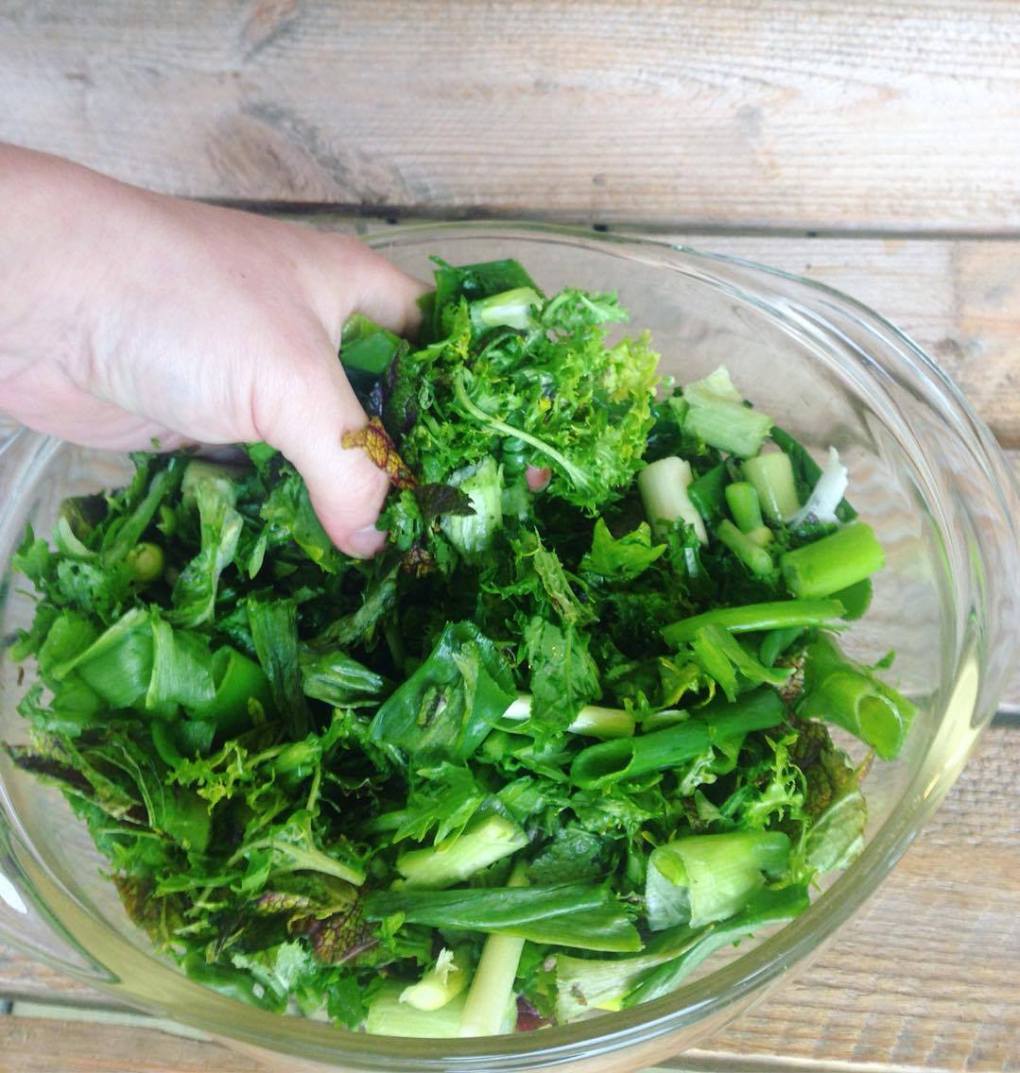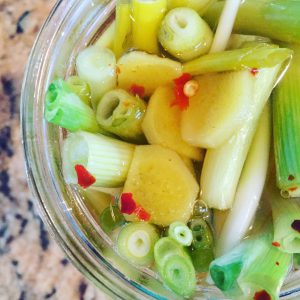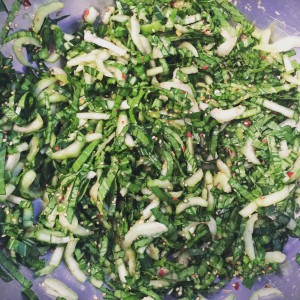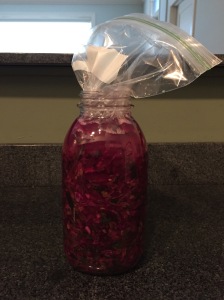Don’t it always seem to go that you don’t know what you’ve got till it’s gone. -Joni Mitchell
It’s hard to believe in the middle of winter, when you’re so hungry for fresh veg you can’t stand it, but by mid-spring sometimes you can get greens fatigue. They just keep coming!
That bounty is wonderful, but when you’re running out of ideas for how to eat them fresh, remember how hungry you were for those greens just a couple months ago. Fortunately, your greens don’t have to go the same way as Joni Mitchell’s proverbial paradise.
Cucumbers, peppers, cabbage, and radishes aren’t the only spring and summer veggies you can pickle. Give your mustard and other spicy, peppery greens the same treatment, and you can have a taste of spring even after summer has passed.

Dưa Cải Chua is a Vietnamese dish of pickled Spicy Asian Mustard Greens. It’s simple to make and easy to customize to your preferred palate—you can adjust to find your perfect balance of salt, sweet, sour, and spice. And best of all, you can make it with what’s in your share and a few common items in your pantry.
You’ll need:
2 bunch mustard greens, about 4 pounds
4-6 cloves of garlic
1 bunch of spring onion or white onion
Large pot boiled water
2.5-3 tablespoons salt
3 tablespoon sugar
Sriracha, Sambal Oelek, minced Sereno Peppers, or Szechuan Peppercorns
Fish Sauce (optional)
Clean mason jars
A Kraut Source fermentation kit (we sell them at our booth!) or ziplock bags & mason jar lids
Clean and separate your mustard greens and onions. Pick out any leaves that have gotten too yellow—though a little yellow or limpness is ok, as Dưa Cải Chuaa is a great way to use up greens that have languished in the back of your fridge a little longer than you intended (shhh, we won’t tell). A salad spinner an a little chilled tap water will do the trick.

Dry the leaves and shred, then slice the onions. Some recommend letting the greens air dry and get limp for up to 12 hours. Others to simply pat dry with paper towels. It depends on how much time and counter space you have, and how fresh your mustard greens are. Once your leaves are dry, massage them till they are even more limp and even start to sweat a little. Mix with your onions and garlic and set aside.
Rinse your mason jars with boiling water to sterilize them. While the jars are cooling, use remaining boiled water to make a brine with the salt, sugar, and whatever spices you are adding. Taste with a clean spoon as you go to make sure you like the level of heat and balance of flavors.
Sriracha will produce a sweeter, milder Dưa Cải Chuaa. Sambal oelek will be spicier. Minced serano peppers are more traditional, but can get very spicy very quickly. Sezchuan peppercorns will be a different flavor—making the dish more Chinese than Vietnamese— and the level of heat will depend on how fresh your peppercorns are. Fish sauce will make it saltier and add an extra briny, umami flavor.

Pack your jars with the blend of mustard greens, onions, and garlic as tightly as possible. Press them down with a rubber spatula, which you can also use to break up air pockets. Pour the brine in with a funnel, until the greens are covered by at least an inch of brine. Don’t overfill your jars though—you want the brine to sit just below the neck of the jar, at least an inch from the lid.
This is when you either screw on your Kraut Source fermentation kit lid or, if you don’t have one, gently press a plastic bag into the mouth of the jar. Fill with tap water, taking care not to spill. The water will press the baggie flush against the top of the brine, making the contents air tight. Secure lip of the baggie to the mouth of the jar with a rubber band.

Let the Dưa Cải Chuaa sit on your counter for a week. After it’s done fermenting, take your baggies or Kraut Source lid off, and replace with regular mason jar tops. The Dưa Cải Chuaa will keep for months in the fridge unopened, much like kimchi or sauerkraut.
Traditionally, Dưa Cải Chuaa is eaten much like kimchi or kraut, used to add flavor to soups, salads, meats, rice, and more. Add it to stir fry, grain bowls, eggs, or noodle dishes.

If you used Szechuan Peppercorns for more of a Chinese flare, add your pickled greens to Dan-Dan Noodles, a traditional spicy Szechuan dish made with thick, chewy noodles in a spicy soy-based sauce. For a Japanese-style meal, fry some of your Dưa Cải Chuaa (called Takana in Japan) in sesame oil before adding to rice.
Or if you want to stick close to Vietnam, you can make Canh Dưa Cải Chuaa, a beef soup with pickled mustard greens. Or add to another Vietnamese dish Thịt Kho. a slow-braised pork dish with eggs. It would also be wonderful in Pho.








